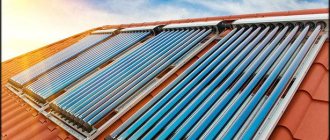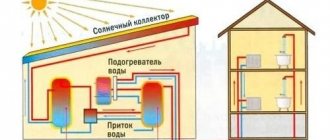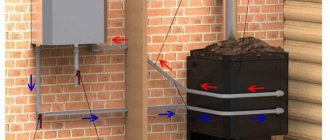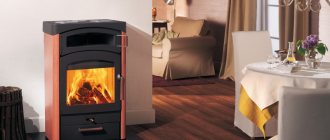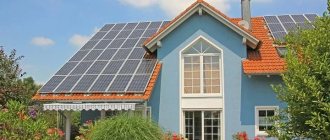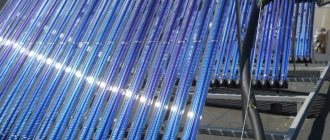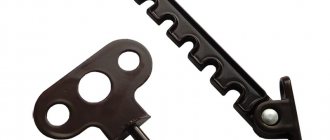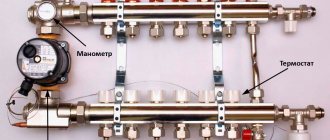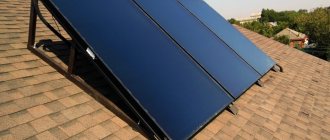Who wouldn’t want to reduce heating costs, especially in the face of constantly rising energy costs?
The simplest way to achieve this is to absorb solar heat, which can be consumed without any conversion.
Of course, in winter it comes to our latitudes in very meager quantities, but this should not be neglected. Moreover, to collect it you will need an extremely simple and cheap device that you can easily make yourself.
In this article we will talk about how to make an air solar collector with your own hands for heating a house - device, diagrams, designs.
Design and principle of operation of a solar collector
In its design, the solar collector is the opposite of the radiator of the heating system. If the walls of the radiator are heated by the coolant, then in the collector, on the contrary, the coolant is heated by the walls.
The walls themselves, in turn, heat up due to the absorption of solar heat (they are painted black), due to which this part of the collector is usually called an absorber.
Solar system in an autonomous heating system
The absorber material must have high thermal conductivity, so at home it should be made of copper or aluminum. In factory-made collectors, the absorber is made of special alloys, which are characterized not only by high thermal conductivity, but also by low intensity of infrared radiation.
For obvious reasons, it is advisable to make the contact area of the coolant with the absorber as large as possible, so the latter is usually equipped with ribs or similar structural elements.
Alternative heating is used quite rarely, and many people wonder whether a solar collector is effective in winter. Types and expediency of its use.
Tips for making a solar collector with your own hands are presented here.
It makes sense to make a solar water heater with your own hands, if only because the energy obtained from its operation will be absolutely free. In this topic you will find instructions for making such a unit.
Device efficiency
To calculate a solar air collector, you will have to take into account many factors:
- Active area of the adsorber;
- Number of air channels;
- Angle relative to the position of the sun;
- Length of air channel route.
It is believed that this type of heating becomes effective when the average volume of solar energy supplied per square meter of adsorber exceeds 1 kW.
DIY solar air collector for heating: diagram
To avoid heat loss due to contact with street air, the absorber of a homemade collector is placed in a well-insulated wooden case, covered on top with transparent plastic (polycarbonate or plexiglass) or durable tempered glass.
For factory-made collectors, the absorber tubes are placed in evacuated flasks, so that the heat is stored in them, like in a thermos.
Solar collector assembly diagram
Both air and a liquid medium - water or antifreeze - can be used as a coolant. We will consider the air manifold, since it is easier to manufacture.
The relevance of organizing a solar system
Installation of solar panels
Before purchasing or making a converter yourself, you should find out whether heating a private house with solar panels will be efficient enough. To do this, it is necessary to conduct a detailed analysis of all factors affecting the efficiency of the future system.
First, the solar insolation indicator is determined. This is the amount of solar energy falling on the surface of the earth in a particular region. The degree of heating of the coolant or the volume of generated current will depend on this. Solar radiators for heating a home should ideally operate regardless of the season. However, in reality this does not always work out.
Solar insolation
Also, a passive solar heating system can change its operating efficiency due to the angle of the panel. It also depends on the season. To determine the theoretically possible energy, you can use the data from the table.
Already on the basis of these data, it is possible to make a calculation of the solar collector for heating, taking into account its technical and operational characteristics. But besides this, the following factors should be taken into account:
- Location of the house. The fall of the sun's rays should not be obstructed by natural or artificial objects - mountains, tall buildings, tall forests, etc.;
- Place for installation. Combined solar heating will require a large space - from 2 to 10 m². Most often, the roof of the house is used for this. At the same time, it must be adapted for the installation of collectors or solar panels;
- Required thermal power. Often, solar heating systems for a private home are used as auxiliary ones.
Solar energy values (kWh) for Russian regions
Only after this analysis can you begin to select a specific scheme for alternative heating supply to your home. The heat losses in the house are preliminarily calculated, and the optimal thermal operating mode of the heating is determined. If the solar collector in the heating system is auxiliary, the same indicator of the main heating system is added to its rated power.
When calculating, you need to take into account the weight of the equipment. The roof surface must withstand this load.
Determining the installation location and available space
The installation location of the collector must meet the following requirements:
- The device should be located as close as possible to the consumer, that is, the room into which the heated air enters.
- The panel should face as far as possible due south or as close to this direction as possible. In this case, it is highly desirable to position its surface at right angles to the sun’s rays, as a result of which losses due to reflection will be minimal.
- The location where the collector is installed should not be shaded by trees, pipes or buildings.
There are no restrictions regarding the choice of collector area: the larger it is, the higher its productivity will be and, accordingly, the lower the amount of heating bills will be.
How it works
The collector collects energy using a light accumulator or, in other words, a solar receiving panel, which transmits light to an accumulating metal plate, where solar energy is converted into thermal energy. The plate transfers heat to the coolant, which can be either liquid or air. Water is sent through pipes to the consumer. With the help of such a collector you can heat your home, heat water for various household purposes or a swimming pool.
Air collectors are used mainly for heating a room or preheating the air inside it. The savings when using such devices are obvious. Firstly, there is no need to use any fuel, and secondly, electricity consumption is reduced.
Selecting a collector absorber design
It is proposed to make the absorber tubular, that is, consisting of several parallel tubes connected at the inlet and outlet by distribution combs.
In this case, for the manufacture of this part of the collector, you can use a very affordable and convenient material - aluminum cans for carbonated drinks.
They are ideal for this purpose, as they have a number of advantages:
- Aluminum, as already mentioned, has high thermal conductivity.
- The thin wall of the can can be easily cut with a regular knife.
- In the vast majority of cases, beverage cans have a standardized size (with a volume of 0.5 liters - 168x66 mm).
- For ease of storage and transportation, the cans are specially shaped so that they fit well together (the upper edge is narrowed to a diameter of 59 mm, and the bottom is given a concave shape).
- After consuming the contents of the can, they are usually thrown into the trash, so this material is absolutely free for the future owner of the collector.
Sometimes cans are made of steel. It is not difficult to identify such containers, since, unlike aluminum ones, they are attracted to a magnet. They should be discarded.
Before assembling the panel, be sure to wash the cans with detergent, otherwise the air passed through them will have an unpleasant odor.
Solar installations for hot water supply and heating systems
Solar collectors, which are used as a device for heating any liquid (most often water) for the purpose of using it in hot water supply or heating systems, have become very widespread and popular.
Another type of equipment for converting solar energy is batteries, which are fundamentally different from collectors in that they first generate and accumulate electrical energy, and later it can be used for household needs.
But this type of solar energy production and processing requires the purchase of expensive equipment, the main structural units of which are photovoltaic cells, which is not always justified, especially in regions with a small number of sunny days per year.
In contrast, solar collectors for heating water or heating a house have a quick payback, especially if you make them yourself, since in this case the costs will only be the cost of materials, which do not include expensive solar cells.
The use of solar collectors has obvious advantages:
- reduction of heating and water heating costs for the hot water supply system;
- environmental friendliness of this type of energy.
Most often, the use of collectors is justified for use in heating systems of small cottages or for organizing hot water supply in the summer in a country house or dacha. A solar collector for a swimming pool is justified as a device for heating water.
This is explained by the relatively low efficiency of such installations, which can decrease significantly on cloudy days.
Therefore, to optimize heating costs for a private home, it is best to use collectors in conjunction with traditional equipment, which can initially be designed for this, or has the ability to re-equip or coordinate the parallel operation of two heat supply systems.
It is also worth noting that, in addition to regular maintenance and cleaning the surface of the collectors from dirt and debris, some of them are not designed to operate at low temperatures, so before the start of winter they need to be preserved by first draining the coolant from the system.
Main types of solar collectors
A solar collector is a device whose main function is to convert absorbed solar energy into thermal energy for the purpose of its further use for heating the coolant in heating systems, including “warm floors” and domestic hot water supply.
The efficiency of the collector directly depends on two factors: the type of device and its area, so the roof of a building is often chosen for its installation.
Solar collectors can be conditionally classified using different criteria. First of all, they are divided according to the type of coolant into:
- water (liquid);
- air.
According to the level of maximum temperatures, collectors are:
- low temperature – limit up to 50°C, average 35-45°C;
- medium temperature up to 80°C;
- high temperature – more than 80°C.
The latter are most often industrial designs; it is not possible to make them yourself.
Structurally, solar water heaters can be:
- flat, which can be either air or liquid;
- vacuum, using water or another type of liquid as a coolant;
- tubular - there are both liquid and air;
- thermosiphon, or so-called storage integrated collectors, the main difference of which is the ability not only to heat the liquid, but also to maintain its temperature for a certain time.
The last option is the simplest both in terms of design and manufacturing complexity and consists of several thermally insulated containers with water, and the liquid is heated through the glass lids of the tanks.
This type of collector can be considered the easiest to maintain, since in order for it to work, you only need to periodically clean the container lid, but it is impossible to use it in the cold season.
Flat air collectors are also quite simple and look like a special panel in the form of a sealed box with a heat sink with connected air ducts through which the air moves and is heated.
To increase their efficiency, it is necessary to increase their area, for example, through the use of several panels in one system, as well as the use of a fan.
Manufacturing of the collector body and its thermal insulation
The manifold proposed for production will consist of 8 tubes of 8 cans each. Moreover, its body will have dimensions of 1400x670 mm. To make all the elements of the box (case), you will need a sheet of plywood measuring 1525x1525x21 mm. The following parts need to be cut from it:
- Bottom size 1400x670 mm - 1 pc.
- Walls measuring 1400x116 mm - 2 pcs.
- Parts measuring 630x116 mm - 4 pieces (2 are used as walls, the other 2 as guides for cans).
The edges of the parts will most likely have to be processed, for which when marking you should leave an allowance of 3 to 5 mm.
Since the collector will be installed outside, all wooden parts must be treated with an antiseptic or painted.
Creating a collector
When assembling the box, the parts are fastened together using corners and some kind of screws, for example, furniture screws measuring 6.3x50 mm (they are called confirmats). The holes for installing such screws are made with a drill with a diameter of 4 mm.
Each part must be sealed with silicone sealant during assembly to ensure the box is airtight.
From the inside, the bottom and walls are covered with foam plastic 20 mm thick, and then with any foil thermal insulation (foil inward, that is, towards the absorber).
Advantages and disadvantages
Air solar systems, like all human creations, have their strengths and weaknesses. The advantages include:
- efficiency in air drying;
- low cost;
- simple design.
But there are also disadvantages:
- Air collectors cannot be used to heat water;
- they are quite large (due to their low heat capacity);
- they have modest efficiency.
Note! To increase the efficiency of solar air systems, they are installed in the walls (southern, as we remember) during the construction of the building.
You can make such a device yourself, since its design, as already noted, is quite simple. This will require cheap and accessible materials (some even manage to use tin cans).
But remember: such collectors are quite large, so it is likely that you will have to build a structure that covers the entire wall.
Manufacturing guides for the absorber
In each of the guides, using a crown, you need to drill 8 holes, the diameter of which corresponds to the diameter of the can. In this case, the jar should fit tightly enough into the hole.
The guides are installed on both sides of the box, and the absorber tubes are installed between them.
Thus, the cans in the tube are pressed against each other without any clamps.
Solar energy is an alternative heat source
The idea of using solar energy for heating is not new. Moreover, the feasibility of its use has been proven by the Americans, Chinese, Spaniards, Israelis and Japanese.
The market is replete with offers of various installations for converting solar energy and its further use for economic needs.
Solar systems are actively used as the main source of heat in many countries around the world. In our latitudes it is still used as an addition to the heating system
The cost of systems depends on their type, area, and material used in manufacturing. From year to year there is a steady downward trend in prices for all types of solar installations - solar systems.
This makes them more accessible to a wider population. But not everyone is ready to make such a purchase yet.
But, if you wish, you can build an effective solar heating system with your own hands, spending significantly less money.
A conventional heating system that has performed its functions perfectly for many years is becoming more and more expensive. The reason for this is the global rise in prices of energy resources throughout the world. The owner’s natural desire is to save on heating, which eats up a significant share of the family budget.
So, a solar heating system can fully replace the usual solid fuel, gas or any other. It all depends on the type and size of the room in which it will be used.
An option suitable for a granary will not be suitable for a residential building, and a system that satisfies the needs of a summer house cannot cope with the heating of a 2-story mansion.
Completely replacing traditional heating with solar is sometimes problematic. The owner is afraid that the system may not cope or there is not physically enough space to install the required number of panels.
Therefore, they often use a combined heating system without completely abandoning the installed gas (electric or other) equipment. The level of replacement of conventional heating with solar can reach 90%.
Also, the annual number of sunny days of the area in which the home is located is important. Moreover, the average daily temperature is not so important
Many installations effectively absorb light on frosty winter days (solar collectors using antifreeze as a coolant).
In addition to heating, a solar installation can provide a home with warm water and electricity.
Manufacturing of absorbers
We assemble the tubes as follows:
- The wall covering the top of the jar (in which there is a hole) is cut with metal scissors into “petals” that are bent inward. It is convenient to bend the “petals” by placing the can on a plastic pipe of the maximum possible diameter (so that it fits inside the can).
- In the bottom of each can, using a conical drill, you need to make 3 holes with a diameter of 20 mm, so that their centers are at the vertices of an equilateral triangle.
- Now you can collect tubes from the cans - 8 pieces each. in each. The joints of the cans should be sealed with high-temperature chimney sealant, for example, High Heat Mortar brand. This composition should be applied to a previously degreased and moistened surface. The composition is leveled with your fingers, wearing rubber gloves, which should also be moistened with water.
To ensure that the tubes are perfectly straight, when assembling the cans, they should be placed in a template made from two boards and shaped like an equal angle. It is installed at a slight angle to the vertical (you can lean it against the wall).
A weight must be placed on top of the newly assembled tube, located in the template, until the sealant is completely cured.
What is it and why install it
A solar collector is a device that converts solar energy into heat. With the help of a solar air system, you can heat various rooms for free: residential buildings, warehouses and garages. Another option is to make a solar water collector from corrugated sheets, which is suitable for heating water in an apartment. If there is a swimming pool on the site, the craftsmen advise collecting it.
Main advantages:
- low cost. A collector, powered by sunlight and air movement, can be made from scrap building materials found in the garage;
- easy assembly. There are different models of solar collectors, but the general operating principle is similar. Even a beginner who has just begun to be interested in construction and construction can assemble the structure;
- high efficiency. Technical characteristics for different designs may vary, but on average the efficiency reaches 45-75%;
- reliability. The parts of the solar collector are in a static position, so the risk of breakdowns and wear of the elements is minimal.
In order for the solar installation to work as efficiently as possible, you should select in advance the optimal location for its placement. Usually the collector is placed on the sunny side near the wall of the building or on the roof.
Assembly of an air solar collector
Having laid the tubes on a horizontal surface in the form of a battery, each of them is lubricated on one side with sealant and installed in the guide. On the other hand, a second guide is installed on the battery, also using sealant. Before the sealant hardens, the guides should be tightened with an elastic band. At this stage, the battery along with the guides on top should be painted with matte black paint.
Bonding aluminum cans for solar collector
Next, the assembled absorber is installed in the box. Before this, grooves for the guides should be cut in the foam. The space available on each side between the wall of the box and the guide will act as a distribution comb. At this point, holes should be cut in the bottom of the panel to connect the collector to the air ducts. The top of this space needs to be covered with plastic clapboard.
A sheet of transparent plastic (plexiglass made of polycarbonate or acrylic) is installed above the absorber, which is placed on the sealant and screwed to the walls with screws and a press washer.
What materials will make the collector most efficient?
Let's dwell on the design of a solar collector made of corrugated sheets or sheet aluminum; the use of steel pipes reduces the efficiency of the solar storage device; the use of thin-walled aluminum profiles gives the best effect, but requires money and equipment. Specifically, a 30mm PAS-1828 pipe will cost about a dollar per meter, in addition, a large amount of welding work using electric welding with argon, which will also cost about half of all costs.
A collector made of corrugated sheets collects heat about half as well, but is several times cheaper. The decrease in efficiency is easily compensated for by making the surface area of the structure larger.
In addition to corrugated sheeting, you can use aluminum sheets used for thermal insulation of furnaces or heating circuits. If we make a profile out of it, similar to corrugated sheeting, we will get a structure that, despite its cheapness and ease of work, is not inferior to a solar collector made of aluminum pipes.
Connection
The collector is fixed to the roof using a bracket and connected to two air ducts leading into the room. A fan with a capacity of about 150 cubic meters should be installed on the inlet air duct. m/h.
Factory-made solar panels are very expensive, and they will not pay off soon. Do-it-yourself solar panels are much cheaper to manufacture, and assembling the structure is not so difficult.
Types of solar panels for home heating are presented in this review. And also about the pros and cons of each option.
Design options
There are two types of solar heaters that heat using the greenhouse effect:
- Passive - provide natural air circulation through channels.
- Active – carry out the transfer of the working environment forcibly.
The designs of heating systems based on solar collectors also differ in the principle of air supply. When the air mass is captured from outside, after which it is heated and released into the premises, this is called a ventilation system.
If cool air that needs heating is taken from inside the room, and after warming up in the collector it is returned, then this is a recirculation option.
Additional costs associated with operation
Using this does not imply any care or maintenance other than periodic cleaning of dirt and snow in winter (unless it thaws itself). However, there will be some associated costs:
Repairs, everything that can be changed under warranty can be replaced by the manufacturer without any problems, it is important to buy an official dealer and have warranty documents. Electricity, very little of it is spent on the pump and controller. For the first one, you can install only 1 solar panel of 300 W and it will be quite enough (even without a battery system). Flushing the coils will need to be done once every 5-7 years
It all depends on the quality of the water (if it is used as a coolant).
Prices for factory devices
The lion's share of the financial costs for the construction of such a system falls on the manufacture of collectors. This is not surprising; even in industrial models of solar systems, about 60% of the cost comes from this structural element. Financial costs will depend on the choice of a particular material.
It should be noted that such a system is not able to heat the room; it will only help save on costs by helping to heat the water in the heating system. Considering the fairly large energy costs that are spent on heating water, a solar collector integrated into the heating system significantly reduces such costs.
The solar collector is quite easily integrated into the heating and hot water supply system (+)
Quite simple and affordable materials are used for its manufacture. In addition, this design is completely energy independent and does not require technical maintenance. Caring for the system comes down to periodic inspection and cleaning of the collector glass from dirt.
